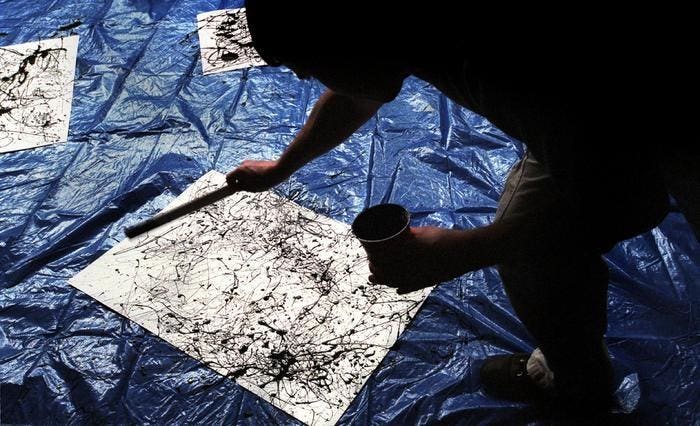Have you ever looked at a Jackson Pollock painting and thought “I could do this”? According to researchers at the University of Oregon, you might be wrong about that – unless you happen to be a child.
In a study that was recently published in Frontiers in Physics, the team of physicists and psychologists wanted to learn more about Jackson Pollock’s famous Action Painting method, and how he created his unique style.
The study was led by physics professor Richard Taylor, who previously used machine learning to distinguish between real and imitation Jackson Pollock paintings. As part of that study, he had invited people to try their hand at making their own Pollock-style drip art. During these “Dripfest” events, people saw examples of Pollock’s work and then made their own using the same technique of pouring and throwing paint on the canvas.
A participant at a ‘dripfest’ creates a painting in Pollock’s style.
Richard Taylor
Pollock’s unique painting style has been captured in the short film “Jackson Pollock 51” by Hans Namuth in 1951:
The style is seemingly easy enough to replicate for both adults and children. But Taylor and his colleagues wondered whether there was a difference in the way that adults and children make this kind of art. And if there is, which of them paints most like Pollock?
Play Puzzles & Games on Forbes
Altogether, the researchers had 34 paintings created by young adults (aged 18-25), 18 from children (aged 4-6) and Pollock’s originals to analyse.
Jackson Pollock art as fractals
To determine the differences in the paint patterns that each group created, they simplified these patterns into the “bones” (the main path of the paint) and the “skin” (the drips that regularly appear along these paths). They then used fractal analysis to mathematically describe the patterns.
Fractal analysis has many different applications. Essentially, it’s used whenever researchers need to describe or compare data with certain complex patterns. Here it’s images of Pollock replicas, but it can also be used to analyse medical or scientific images, patterns in natural elements like trees or rocks, and even economic data.
The fractal analysis that the researchers did on the Pollock paintings looked at how the drip patterns were distributed on the canvas and at the size and number of gaps formed in between the paint path.
After analysing all the paintings, they noticed clear differences in the fractal patterns between the adult and kids paintings. “Our study shows that the artistic patterns generated by children are distinguishable from those created by adults when using the pouring technique made famous by Jackson Pollock,” Taylor told Frontiers. “Remarkably, our findings suggest that children’s paintings bear a closer resemblance to Pollock paintings than those created by adults.”
The biomechanics of making Jackson Pollock paintings
A possible explanation for these differences lies in the way that adults and children move their bodies. Small children don’t yet have the same biomechanical balance as adults. They’re still developing, and more often thrown off-balance than adults. Since Pollock’s style requires a lot of physical movement, the researchers think that this could account for the difference in paintings done by adults and children. But what does that say about Pollock?
Taylor previously documented that Pollock scholar Francis O’Connor said that “Pollock’s birth trauma (strangled by his mother’s umbilical cord) and the attendant symptomology of loss of manual dexterity was decisive in his art”. Even though there is no medical account to back it up, this could account for Pollock possibly having a less developed sense of balance.
“Along with Claude Monet’s cataracts, Vincent van Gogh’s psychological challenges, and Willem de Kooning’s Alzheimer’s condition, art historical discussions of Pollock’s limited biomechanical balance serve as a reminder that conditions that present challenges in aspects of our daily lives can lead to magnificent achievements in art,” Taylor said.
The unique art style of Jackson Pollock has been the subject of various other research studies. For example, researchers in Mexico used fluid mechanics to replicate Pollock’s drip style in 2019.









